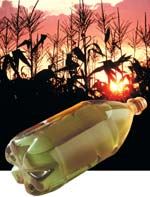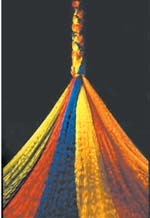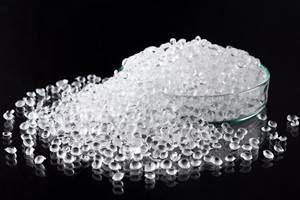K 2001: A Big Show for Additives
Plastics additives don't normally get star billing at trade shows, but this month's K 2001 exhibition (Oct. 23 to Nov. 1) in Dusseldorf, Germany, is different.
Plastics additives don't normally get star billing at trade shows, but this month's K 2001 exhibition (Oct. 23 to Nov. 1) in Dusseldorf, Germany, is different. The number and variety of additives debuting there is greater than at any plastics show in recent memory. Last month, we previewed the wealth of new flame retardants, antioxidants, PVC heat stabilizers, and impact modifiers appearing there. To complete the story, we provide all the details available at press time on uv stabilizers, blowing agents, pigments, color and additive concentrates, lubricants, processing aids, nucleating agents, reinforcements, antimicrobials, conductive additives, coupling agents, and crosslinkers.
Protection from light
In uv stabilizers, here's the latest from Ciba Specialty Chemicals (U.S. office is in Tarrytown, N.Y.):
Shelfplus UV is a uv filter based on proprietary new light-absorber chemistry. It is designed to protect contents of clear plastic packages, including foods, beverages, and personal-care products. According to Ciba, it has excellent processing stability and gives PET bottles broadband uv protection.
Tinuvin XT is a family of HALS based on proprietary chemistry and designed for weatherable polyolefins. Tailored products are geared to specific applications such as molded-in-color automotive TPOs, polyolefin roofing membranes, and molded-in-color, impact-modified PP for siding, window profiles, and shutters.
Tinuvin FR is also based on proprietary HALS chemistry and is said to impart both light stability and flame retardancy to PP moldings for exterior applications such as stadium seats.
Tinuvin hydroxyphenyl benzotriazole uv absorbers are offered in a new form—ED (Easily Dosable) granules. Reduced friability, low dusting, and narrow particle-size distribution facilitate more precise dosing control.
Great Lakes Chemical Corp., Indianapolis, has expanded its product line with two new benzotriazoles to supplement its benzophenone uv absorbers. Lowlite 29 is designed for use in acrylic and PS, while Lowlite 35 is for polyolefins and PS. Great Lakes also has a new nickel quencher for PE agricultural film in hot climates where irradiance is severe and resistance to pesticides is required. The company will also offer it in an NDB together with a proprietary octoxy benzophenone.
Great Lakes recently introduced a high-molecular-weight HALS, Lowlite 94, that is similar to Ciba's Chimassorb 944. It is aimed primarily at polyolefin films and moldings.
A name not usually associated with uv stabilizers, Milliken Chemical of Spartanburg, S.C., will introduce an additive for PET food and beverage containers that is said to protect the contents from uv degradation.
Additive concentrates
A fistful of new additive concentrates for polyolefins will be featured by Ampacet Corp., Tarrytown, N.Y.:
PE concentrate 101950 UVA contains Shelfplus UV, the new uv filter from Ciba Specialty Chemicals. This additive is said to outperform other uv absorbers in that it can block 90% of light up to 390 nm wavelength. Its lack of color is an added benefit in that it doesn't interfere with bottle appearance. This first product is designed for use at 2% in HDPE bottles. A PET concentrate of Shelfplus UV for PET bottles is in development.
Product 101501, a non-migrating slip-additive concentrate for blown film, is said to be based on a unique alternative to the usual oleamide or erucamide. It produces an immediate reduction in coefficient of friction (COF) that will not change over time. It will yield a COF of 0.3 when used at a 10% level. Because of the higher-than-normal loading, it performs best in the skin layer of multilayer structures, but it is acceptable for food contact, according to Ampacet.
Also non-migrating is a new antistat concentrate for non-food uses. Ampacet says Product 101710 is based on totally new chemistry. It is most effective at use levels of 30-40% and is thus best suited to the skin layer of multilayer structures.
Ampacet has two new products for thin (1-micron) skin layers of multilayer BOPP films. SAT062, which is both an antiblock and hot-slip agent, is designed for cigarette packaging film. At 5-7% usage in a skin layer, it can achieve film/film COF of 0.2 at 70 C and film/metal COF of 0.3 at 70 C.
Seablock43 SAT, touted as a new type of antiblock masterbatch, is said to be an unusual combination of organic particles in a new PP terpolymer vehicle. The terpolymer is used for films that require very low seal-initiation temperature and good hot-tack properties. The additive reportedly provides COF reduction, good antiblocking properties, and excellent optical properties in the terpolymer films. Because its ingredients are non-migrating, the concentrate can be used in metalized films. Typical use level in the skin layer is 3-5%.
Product 101802 is a film processing-aid masterbatch consisting of 70% mineral particles in a low-melt-index LLDPE carrier. At 25-30% use levels, it significantly boosts film properties including a 30% increase in dart impact, 30-40% increase in flex modulus, and 20% decrease in MVTR. Recent field trials have demonstrated 20% higher linear throughput.
Ampacet will also feature a new series of 50% antiblock concentrates in PE carriers with combinations of slip, uv, and processing aids, as well as a line of additive concentrates for use with acid copolymers and their salts.
Concentrates for foam
Clariant Corp.'s Masterbatches Div., Milford, Del., will introduce the latest additions to its Hydrocerol line of chemical blowing-agent (CBA) masterbatches:
CT-1376 endothermic/exothermic CBA for ABS is designed to provide uniformly small cell size, which results in superior impact and tensile strength.
CT-1210, CT-1212, and CT-1157 exo/endothermic masterbatches for free-foaming PVC profile, sheet, and pipe are said to provide uniform and very fine cell structure and to reduce the incidence of voids in thick-walled parts.
CT-1395 endothermic CBA is designed to provide a more "leatherlike" feel to modified-PBT steering wheels.
CT-1401 endothermic is designed for wood-filled polyolefin composite lumber.
Black, white & colors
Ampacet is featuring several new black and white concentrates, as well as a blue for mulch film:
White products 11500 and 11700 contain 50% and 70% TiO2, respectively. Whites 111122 and 111150 are 70% loaded with a blend of opacifiers. The two latter products are said to be "softer" than products containing only TiO2, thereby reducing equipment wear.
White 111120 is designed to reduce wear on pin-gates used for high-speed injection molding of thin-wall containers and lids. It has 70% pigment in a high-flow carrier, but its opacity is equivalent to 50% TiO2. New White 111052 for mulch film contains a new-generation HALS that is less reactive with agro-chemicals.
New Black 190858 for pipe coating contains 45% of a very clean N-330 type carbon black. It is used at only 5% levels.
Ampacet's three new mulch-film concentrates include Blue 120 with a HALS in an LDPE carrier. It is used where annual uv exposure is 120 Klys—i.e., in southern Canada, the northeastern U.S., most of the Midwest, plus Washington, Oregon, and northern California.
Blue 140 is similar to the above, but also contains an antioxidant and an LLDPE carrier. It enables film to meet sun exposure of 140 Klys in the southern U.S. and central California.
Blue 160 is like Blue 120 but with more antioxidant in LDPE/LLDPE carrier. It meets exposure of 160 Klys in southern California, Arizona, New Mexico, Mexico, Central America, and northern South America.
Meanwhile, Milliken Chemical will feature new liquid colorants for PET.
More colorant news
Ciba Specialty Chemicals will unveil a new addition to its high-performance azo pigments. In HDPE, Cromophtal 2000 is said to combine the outstanding color properties of Cromophtal Red 2030 with non-warping characteristics typically associated with inorganic pigments. Excellent dispersibility and processing properties are also claimed.
Clariant's Pigments & Additives Div., Charlotte, N.C., will showcase two new organic yellows and two new red pigments that boast excellent heat resistance and light fastness:
Polysynthren Yellow NG is a mid-shade yellow (color index P.Y. 147) that's soluble in amorphous polymers. It is suitable for coloring PC, acrylic, PBT, acetal, and ABS.
PV Fast Yellow H9G VP 2430 (color index P.Y. 214) is a new pigment for polyolefins, PVC, and styrenics. It reportedly offers the purest and greenest shade of organic yellow available plus good all-around fastness properties. It is easily dispersible and resistant to alkalis. It is also said to process very well in HDPE at up to 536 F.
PV Fast Red E7B VP 2464, a bluish red quinacridone pigment (color index P.R. 202), is suitable for use in all plastics as a mass tone and tinting pigment. It boasts low solubility in nylons and polyesters.
PV Fast THI Red 4G VP 2499 is a pure, yellowish red (color index P.R. 279) based on the chemical structure of thiazine indigo. It has excellent weathering properties and does not induce warpage in polyolefins.
Clariant will also showcase organic pigments in a new physical form suitable for making color concentrates. DrizPearls are fine granules made up of spherical particles with an average size of 200 microns. They contain a wax treatment applied during pigment synthesis. These dust-free and free flowing particles are said to be more easily dispersed than standard pigment powders. Sample quantities are available for testing.
Clariant has new waxes for making pigment concentrates. They include what is said to be the first metallocene-PP wax. It is said to be excellent for dispersing organic pigments in PP for fiber manufacture. Other metallocene waxes are in field tests to evaluate their lubricating effect in PVC profiles, with the aim of increasing output and improving gloss.
Clariant will also show Ceridust 6071 and 5551 micronized waxes, which are newly optimized for use as dispersion aids in pigment concentrates. With a mean particle size of 5 to 30 microns, they are said to significantly reduce the formation of pigment agglomerates, even in the case of some classes of pigments whose poor dispersibility has until now rendered them unsuitable for making concentrates.
Lubricants & process aids
Croda Universal Inc., Houston, will launch a lubricant for caps and cap liners used for bottled water. New Incroslip C is a torque- and mold-release agent that's said to have far better organoleptic (taste and odor) properties than currently used products. Incroslip C is vegetable-based and meets all necessary European and FDA regulations. It boasts exceptional stability and can replace existing additives with minimal reformulation, Croda claims.
Dover Chemical will feature its new Doverlube FL-599 ester of polyethylene glycol with a fatty acid, which acts as a processing aid for HIPS, PS, PE, PP, ABS, and PVC. Its also acts as a clarifier in PP, and it can be incorporated into a purging compound to clean extruders between color changes and reduce black specs.
Axel Plastics Research Laboratories, Inc., Woodside, N.Y., is introducing MoldWiz INT-33UDK, an internal lubricant and processing aid for polycarbonate, whether clear, pigmented, reinforced, or blended with other resins. It also works with HIPS and acetal. It is based on a proprietary blend of synthetic resins and fatty glycerides with modified organic fatty acids, all FDA-approved for food contact. In a recent field test, a PC compounder found that adding 0.5% of INT-33UKD raised melt flow by 22%. By dry blending 0.3% of the product with PC pellets, an injection molder of CD storage racks was able to speed cavity filling and reduce cycle time by more than 11%.
Also new from Axel is MoldWiz INT-40DHT internal lubricant for polyethersulfone (PES) and other engineering resins that are processed at 500-700 F. It improves release and melt flow.
Other additives debut
Making its public debut at K 2001 will be Conoco Cevolution (formerly Conoco Carbon Fibers) of Houston, which will feature its growing line of advanced carbon fibers for use as reinforcements and conductive additives. Its products include mesophase-pitch-based carbon fibers said to offer exceptional strength and conductive properties, as well as a new highly-crystalline specialty graphite product.
Milliken Chemical will launch a new nucleating agent for PP. This novel product is said to be a breakthrough in enhancing crystallization. It will help increase throughputs of plastics products and enable some of them to be downgauged, the company says.
Milliken will also feature a new silver-based antimicrobial product, AlphaSan RC5000, designed for plastics and textiles where color and thermal stability are crucial.
Also from Milliken are Zelec electroconductive powders that dissipate static in plastics and coatings.
Crompton will introduce its latest Polybond coupling agents. These maleic anhydride-grafted polypropylene modifiers are designed for use in wood/plastic composites for fencing and boardwalks. Polybond couples wood fibers to a plastic matrix and also helps bond wood substrates to plastic substrates.
Also new from Crompton is an organic peroxide, DiTAP (di-tertiary amyl peroxide), designed for viscosity modification of polypropylene.
Related Content
Additives Boast Sustainability Without Sacrificing Performance
Sustainability continues to dominate new additives technology, but upping performance is also evident. Most of the new additives have been targeted to commodity resins and particularly polyolefins.
Read MoreK 2022 Additives & Materials: Sustainability in the Lead
Nearly all of the new additives highlighted at the big show are aimed at enhancing recyclability of commodity resins and some volume engineering resins such as nylon and PC. A few new materials, on which we had not previously reported, also surfaced at K 2022.
Read MoreRiverdale Global Showing Latest Innovations and New Satellite Location in Wisconsin
NPE2024: Live demos of updated RGS controller are among the highlights at its Wisconsin facility that will house the ‘new’ color R&D lab.
Read MoreICIS Launches: Ask ICIS Generative AI Commodities Assistant
Said to be the first of its kind, this AI assistant will enhance access to ICIS’ intelligence and insights for the energy and chemical markets.
Read MoreRead Next
People 4.0 – How to Get Buy-In from Your Staff for Industry 4.0 Systems
Implementing a production monitoring system as the foundation of a ‘smart factory’ is about integrating people with new technology as much as it is about integrating machines and computers. Here are tips from a company that has gone through the process.
Read MoreMaking the Circular Economy a Reality
Driven by brand owner demands and new worldwide legislation, the entire supply chain is working toward the shift to circularity, with some evidence the circular economy has already begun.
Read More















